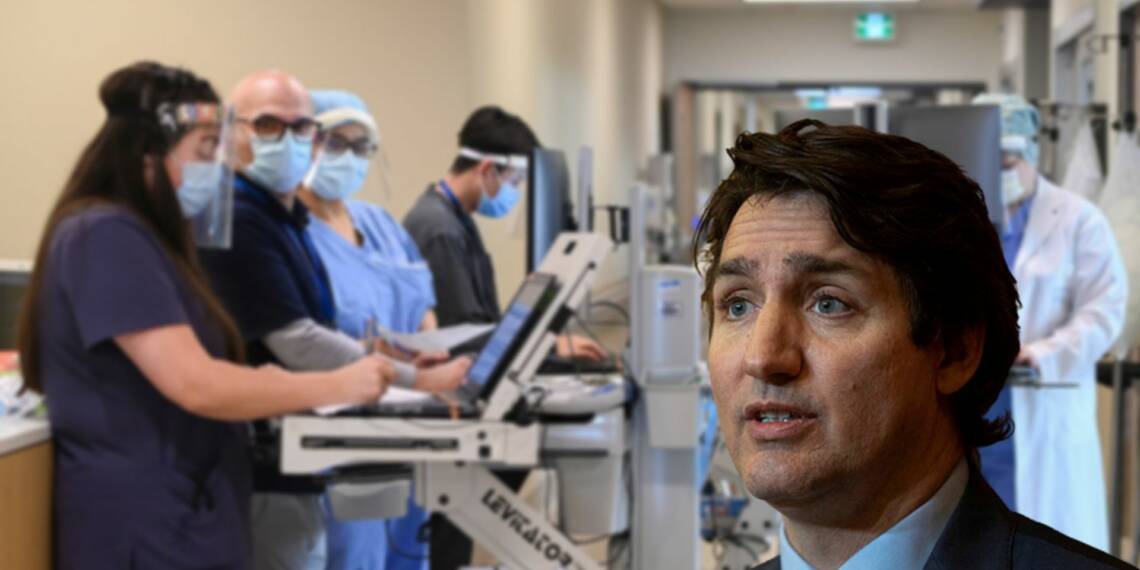Trudeau 10-year health-care deal: Trudeau has a lengthy history of lies and deceit . His incompetence has pushed Canada into a state of utter disaster. The healthcare system in the country is in shambles courtesy Trudeau and his phoney promises.
Trudeau has put a million Canadians’ lives in danger. Backlogs, delayed services, and temporary closures are common in hospital emergency rooms.
Trudeau 10-year health-care deal
The government recently announced an increase in health-care funding after years of policy stalemate. While the government and the media alike are singing praises of the new policy, the reality is quite different.
Despite the rhetoric, hyperbole, and endless stream of figures presented, as well as the hysteria fostered by the mainstream media, the federal government has simply polished off and revved up a 20-year-old Health Accord. Let me explain
In 2004, then-prime minister Paul Martin negotiated a 10-year, $41.3-billion agreement with the provinces, a 10-year health-care deal that promised shorter surgical waiting times, better access to primary and home care, and the creation of health human-resource and national pharmaceutical strategies. It also included a 6-per-cent escalator on payments under the Canada Health Transfer.
A few days ago, current Prime Minister Justin Trudeau proposed a similar 10-year health-care deal with $46 billion in additional money and a 5-percent CHT increase. In exchange, the federal government encouraged the provinces and territories to increase data collection and sharing, as well as to prioritise primary care reform, health human-resource planning, mental health care, and eldercare (both home care and long-term care). The main difference this time is that Ottawa wants to sign 13 bilateral agreements instead of one national deal. As the expression goes, the more things change, the more they remain the same. It’s difficult to think that years of public theatrics and hollow promises resulted in something so bland and unoriginal.
Analysts argue that a $196.1 billion inflow of funds over the next decade, is surely the narrative the Trudeau administration was hoping for. However, there more than what meets the eye. The majority of the money would come from a steady increase in the annual government contribution to health spending, which would occur even if there were no new agreement.
Make no mistake: as the euphoria surrounding the bilateral deals fades, an usual spiral will begin again, with premiers requesting more money. “We see this as a starting point, as a down payment,” Ontario Premier Doug Ford stated.
The Canada Health Transfer now provides $45.2 billion to provinces and territories each year. They arrived at the meeting demanding an additional $28 billion each year, a significant increase. Ottawa offered significantly less, around $19.6 billion per year on average over the next decade. That’s not to be sniffed at. Ottawa’s offer also has extremely limited targeting, with some funds going towards salary increases for personal support workers, mental health and substance abuse, home care, and long-term care.
What’s depressing about the entire process is how much it’s focused on money.
For months and years, premiers and health ministers have fought about the right share of federal and provincial spending, as well as the rates of growth in transfers. The summit of the countries’ top leaders was essentially a reunion of Trudeau’s lackeys, each attempting to create a false sense of bravado around Trudeau rather than genuinely improving health care.
Furthermore, the Trudeau administration has boasted that the money is being provided with no strings attached, other than some courteous requests to exchange data, adhere to the principles of the Canada Health Act, and write “action plans” for how the money would be spent. There is no mention of penalties or clawbacks, and there is no real accountability. But is sharing of health data just a modest request? Certainly not.
We recently explained how, even before the pandemic began, Trudeau struck an agreement with China that provided the CCP access to all critical health care data for Canadians. CCP understood Canadians better than Canadians knew themselves, from health problems to medications. As a result, the provinces should avoid falling into Trudeau’s newfound deception.
So, what does the agreement mean for the provinces of Canada? Zilch, nada, nawt…. If anything, it’s a mechanism for Trudeau to sell Canadian citizens’ health data to China.
Recently the premier of Saskatchewan released a statement on sharing the data of the citizens of the province with the federal government in exchange of receiving the healthcare funding.
“The Government of Saskatchewan is not creating a Digital ID nor will we accept any requirements for the creation of a Digital ID tied to healthcare funding,” wrote Moe.
“The Government of Saskatchewan will not share any personal medical information with the federal government. This information is protected under The Health Information Protection Act and will remain so.” said Moe.
Meanwhile, waiting times in operating rooms, emergency departments, and doctor’s offices continue to rise, as does Canadians’ suffering. Trudeau should have demonstrated actual leadership, and should have come up with a solid commitment to ensuring that every Canadian has ready access to a primary care provider. That would make a significant difference in health care. It’s an initiative that Canadians can budget for, invest in, and track in real time. All the public gets from the existing method – quantitative expenditure growth – is a repetition of the same old Trudean emotive hyperboles. That was the last thing Canadians needed as their health-care systems crumbled around them.
https://www.youtube.com/watch?v=gjWebJt_0J8








